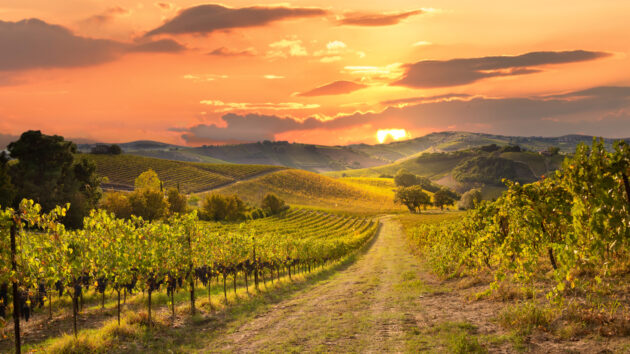2013 Vintage: singing in the rain

Gavorrano , October 10th, 2013 – The sky is still a deep blue, growing lighter in the east and there are still some dark clouds threatening. The grape clusters are wet with dew and it is with some difficulty that we walk over the wet clay soil of the Carandelle vineyard. It is the last day of harvest and smiles are on everyone’s faces. There is a growing sense of satisfaction as the work is so nearly done. A new energy seems to be guiding our scissors quickly and steadily towards the few remaining clusters. There have been many dark clouds and a lot of rain during this last week of harvest, but it has not prevented us from having a happy ending.
Now tasting the wines, some of which are still fermenting, I am reminded of a traditional Italian saying: ‘sposa bagnata sposa fortunata’. Literally translated the expression means ‘wet bride, lucky bride,’ the idea being that rain on her wedding day promises a bride a bright future. Of course these wines are still only a promise of what is to come. We can never really predict exactly what a particular vintage will give us as it continues developing over time, but it is precisely this unpredictability that makes each vintage exciting, unique and interesting. Yet with a vintage that is already revealing so much potential maybe we can say, “Wet harvest, lucky harvest!”
It is not just a very good year it is also the most delayed harvest in the history of San Cristoforo.
The harvest period is only comparable with those of 2010 and 2008, however with different weather patterns over the year.
The 2013 vintage begins from the end of the difficult 2012 vintage. A year that was defined by drought, 2012 left the vines stronger but definitely tired. It was fortunate that 2013’s very rainy autumn/winter period, despite making work in the vineyard difficult, reconstituted the water reserves of our soils.
With the water abundance, soils remained cold for a long time leading to a budburst only in the first ten days of April, two weeks later than average. The temperatures, always low in May and early June, limited vegetative growth, and encouraged a long and heterogeneous flowering. There was also a small amount of millerandage and flower abortion which reduced the final yields per hectare.
Fortunately from the second half of June the warm and overall sunny weather allowed the vines to complete the development of the leaf canopy and their ideal cluster growth. Then July and the first part of August were intensely hot with excellent thermal excursions.
In the second part of August there was a slight drop in the temperature, with nights often going below 20°C, this allowed the grapes to develop and maintain elegant fresh and fruity scents.
The harvest for all our varieties was about ten days later than the average and all took place in the night to ensure that the grapes arrived to the cellar at about 15°C.
The white grapes for the Luminoso were harvested in mid-September and the fermentation took place slowly in a stainless steel vat.
The first sip reveals a wine that is shy in its aromatic expression with an extremely balanced palate. Aging on the lees will be particularly important for the full expression of this wine.
The first Sangiovese for Amaranto, was collected in early October after a sunny late September characterized by moderate temperatures and significant thermal excursions.
Despite the rains, we boldly waited until the middle of October for the last Sangiovese and the Petit Verdot. This delay gave the grapes the time to produce the right balance of sugars, aromatics and polyphenolic potential that only an exceptional year like this one could give us.
SUMMARY
This has been an exceptional vintage for producing wines which reveal a balance between sugars, polyphenols and overall aromatic potential. It is also the latest harvest we have had in Podere San Cristoforo’s history, only comparable to 2010 and 2008 harvests, though with its own distinct weather pattern.
We had a very rainy autumn/winter, which led to a budding two weeks later than the average. The permanent low temperatures in May and early June limited vegetative growth and also lowered the yields per hectare.
From the second half of June until the end of September the warm, dry and overall sunny weather allowed the development of the leaf canopy, optimal cluster growth and the complete ripening of the grapes about ten days later than the average.
The white grapes were harvested in mid-September and the first Sangiovese used for Amaranto, was picked in early October. While the last Sangiovese and the Petit Verdot were picked in mid-October waiting for the highest ripening potential.